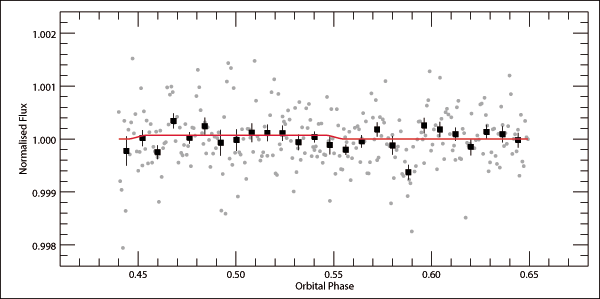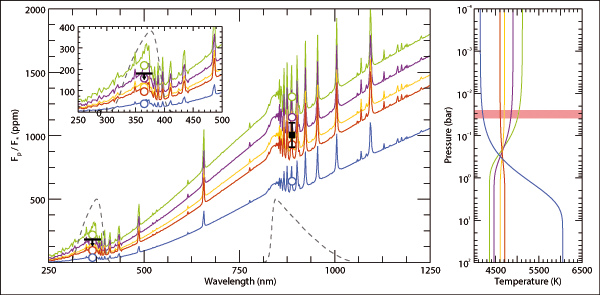ING web news release
3 January, 2019
A Ground-based Near-ultraviolet Secondary Eclipse Observation of the Hottest Exoplanet
The measurement of the drop in flux when an exoplanet is occulted by its host star (also called the secondary eclipse) has established itself as an important tool to study the atmospheres of exoplanets. The characteristic dip in the light curve can be used to quantify the flux associated with thermal emission and reflected light from the dayside of the planet, which allows constraints to be placed on its temperature, structure, composition and energy budget.
A team of astronomers led by Matthew Hooton at Queen's University Belfast (United Kingdom) used the Isaac Newton Telescope (INT) to observe the hottest known exoplanet during its secondary eclipse, which is the first published example of any ground-based secondary eclipse observation at ultraviolet (UV) wavelengths.
KELT-9b is a recently discovered exoplanet in a 1.49 day orbit around a B9.5/A0-type star. The unparalleled levels of UV irradiation that it receives from its host star put KELT-9b in its own unique class of ultra-hot Jupiters, with an equilibrium temperature >4000 K. The high quantities of dissociated hydrogen and atomic metals present in the dayside atmosphere of KELT-9b bear more resemblance to a K-type star than a gas giant.
In July 2017, the team used the INT with the Wide Field Camera (WFC) to observe a single secondary eclipse of KELT-9b. This observation was taken in the U-band, a window particularly sensitive to Rayleigh scattering. A secondary eclipse signal was not detected, but the impressive precision of the WFC photometry allowed a 3σ upper limit of 181 parts per million to be placed on the U-band eclipse depth (see Figure 1).
|

|
Figure 1.
The unbinned normalised light curve (grey points) after decorrelating with seeing and a second order polynomial, and the best fit eclipse model (red line). The data binned by phase 0.008 (black squares) are shown for clarity. Whilst the small negative eclipse depth that our best fit model finds is unphysical, this is indicative of the small signal size compared to noise in the light curve.
Credit: Matthew Hooton. Large format: [ PNG]. |
The dayside flux from KELT-9b was modelled by generating emission spectra for a range of possible temperature-pressure (TP) profiles (see Figure 2), ranging from a strong temperature inversion to a rapid decrease in temperature with altitude. Due to continuum opacity associated with H- ions, which are expected to have a high mixing ratio in the dayside of KELT-9b, the spectrum associated with each TP profile is almost indistinguishable from that of a blackbody spectrum (the majority of the features visible in the left panel of Figure 2 originate in the stellar spectrum).
|

|
Figure 2. Left panel: model spectra for the five temperature profiles shown in the right panel, incorporating flux associated with both thermal emission and scattering. The U-band upper limit described above and the z'-band eclipse depth associated with another observation are shown in black and the expected eclipse depths for each profile are marked with coloured data points.
The response functions associated with the two bandpasses are marked with grey dashed lines. A close-up of U-band wavelengths is shown inset. Right panel: temperature-pressure profiles for each of the spectra shown. The red shaded area shows the pressure levels from which the thermal emission for all the models originate, when approximated as blackbodies.
Credit: Matthew Hooton. Large format: [ PNG].
|
When comparing the brightness temperatures for each spectrum to their corresponding TP profiles, it is apparent that each of these temperatures originates at pressure levels of ~30 mbar (right panel of Figure 2; shaded red), independently of the form taken by each of the TP profiles. This allows the dayside temperature of KELT-9b to be constrained to 4995 K at pressures of ~30 mbar. Although an observational constraint of 0.14 can be placed on the geometric albedo (Ag), the models suggest that the actual value is considerably lower than this due to the H- opacity. This places KELT-9b squarely in the albedo regime populated by its cooler cousins, almost all of which reflect very small components of the light incident on their daysides.
This study demonstrates the capability of ground-based 2-m class telescopes like the INT to perform secondary eclipse observations for hot Jupiters in an age when there will be no space-based alternatives, enabling a tight constraint to be placed on the UV eclipse depth from a single observation. For cooler exoplanets than KELT-9b, this will be a direct measurement of their geometric albedos. To date, all previous studies to detect reflected light from transiting exoplanets have been conducted using space-based facilities. Currently, the only suitable space-based facility with NUV coverage is the Hubble Space Telescope (HST), which is likely to permanently go out of operation in the next decade. Although HST does not suffer the light extinction in the UV that ground-based facilities do, the lower time-pressure on ground-based facilities enables the easier acquisition of several secondary eclipses, which would yield even higher photometric precision than this single observation.
More information:
Matthew J. Hooton, Christopher A. Watson, Ernst J. W. de Mooij, Neale P. Gibson and Daniel Kitzmann, 2018, "A Ground-based Near-ultraviolet Secondary Eclipse Observation of KELT-9b", ApJ, 869, L25 [ ADS ].
|
|



